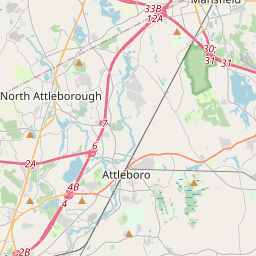September 11, 2001
Historical marker location:
2 West Street, Mansfield, Massachusetts
( Memorial is at the intersection of West Street and S. Main Street, on the left when traveling west on West Street.)







© OpenStreetMap contributors
Loading...
Searching for other points of interest within 3 miles of this location.In 1773, the Boston Tea Party occurred, where American colonists disguised as Native Americans dumped 342 chests of tea into Boston Harbor to protest British taxation.
About Bristol County
Bristol County Timeline
Bristol County, Massachusetts has a rich and vibrant history dating back to the early colonial era. Originally inhabited by the Wampanoag Native American tribe, the area was first settled by Europeans in the early 17th century. In 1639, Plymouth Colony established the town of Duxbury, marking the first permanent European settlement in the county. As more settlers arrived, additional towns were established, including Taunton in 1639 and Dartmouth in 1664.
During the American Revolution, Bristol County played a significant role. In 1776, the Battle of Rhode Island, also known as the Battle of Quaker Hill, took place on the border of Bristol County and Newport, Rhode Island. This engagement was a crucial moment for American forces, as they successfully defended against a British attempt to recapture Newport.
In the 19th century, Bristol County saw rapid industrialization and economic growth. The cities of Fall River and New Bedford became major centers for textile manufacturing and the whaling industry, respectively. Fall River became famous for its cotton mills, while New Bedford became known as the world's whaling capital, with many ships departing from its harbor to hunt for whales in distant waters.
In the 20th century, Bristol County continued to evolve. The decline of the textile industry and the end of whaling led to an economic shift, and the county became more diverse in its industries. Today, Bristol County is known for its mix of suburban, urban, and rural areas, with a thriving economy that includes sectors such as healthcare, education, and technology. The county's rich history, picturesque landscapes, and vibrant communities make it an attractive destination for both residents and visitors.
During the American Revolution, Bristol County played a significant role. In 1776, the Battle of Rhode Island, also known as the Battle of Quaker Hill, took place on the border of Bristol County and Newport, Rhode Island. This engagement was a crucial moment for American forces, as they successfully defended against a British attempt to recapture Newport.
In the 19th century, Bristol County saw rapid industrialization and economic growth. The cities of Fall River and New Bedford became major centers for textile manufacturing and the whaling industry, respectively. Fall River became famous for its cotton mills, while New Bedford became known as the world's whaling capital, with many ships departing from its harbor to hunt for whales in distant waters.
In the 20th century, Bristol County continued to evolve. The decline of the textile industry and the end of whaling led to an economic shift, and the county became more diverse in its industries. Today, Bristol County is known for its mix of suburban, urban, and rural areas, with a thriving economy that includes sectors such as healthcare, education, and technology. The county's rich history, picturesque landscapes, and vibrant communities make it an attractive destination for both residents and visitors.
Bristol County Timeline
This timeline provides a concise overview of the key events in the history of Bristol County, Massachusetts.
- 1685 - Bristol County is established in Massachusetts Bay Colony.
- 1692 - Bristol County becomes part of the newly formed Province of Massachusetts Bay.
- 1746 - County boundaries change with the creation of a new county, Bristol County, Rhode Island.
- 1790 - Population of Bristol County reaches 24,900.
- 1800 - New Bedford becomes the county seat.
- 1820 - Fall River splits from Freetown and becomes a separate town.
- 1840 - Fall River becomes a city.
- 1877 - The City of Taunton becomes the county seat.
- 1892 - The towns of Acushnet and Fairhaven split from New Bedford and become separate towns.
- 1950 - Population of Bristol County reaches 317,101.
- 1997 - Bristol County Superior Court is split into two divisions: New Bedford and Taunton.
- 2000 - Population of Bristol County reaches 534,678.